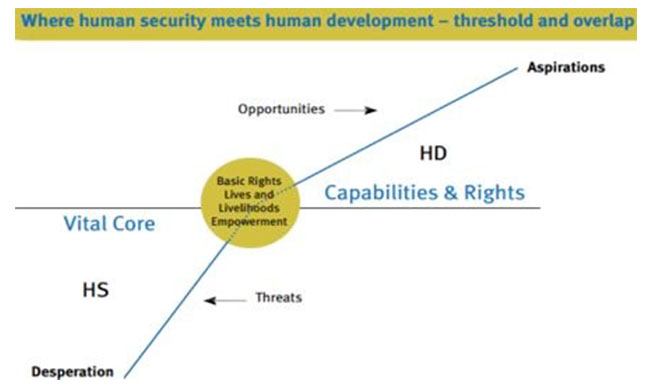The Vital Core of Human Security
The Vital Core of human security represents a set of key interests, values and needs of people that need to be protected. The term ‘vital core’ appears as a fusion of two terms “vital interests” and “core values” (Baldwin, 1997 and Bajpai, 2000) and it appeared for the first time in the article of Sabina Alkire “A conceptual framework for Human Security” in 2003 [1].
The vital core refers to rights and freedoms that pertain to survival, to livelihood and basic dignity. It is a rudimentary but multidimensional set of human rights and human freedoms based in practical reason. It spans the freedom from fear and freedom from want and it needs to be specified by appropriate procedures in any given context (Alkire, 2003).
Thus, the idea of vital core attempts to encapsulate the level below which individuals are not able to lead tolerable lives. The availability of healthy food and clean water, a roof over one’s head, employment, a clean environment, public health and the freedom to worship are just some of the examples of the Vital Core. However, it is important to keep in mind that vital core is highly contextual – what prevents people to live tolerable lives depends upon the context as well as how people experience and perceive their insecurity. Due to this contextual relativity the concept sometimes lacks precision. This imprecision is often the reason why human security was seen as impractical or insufficiently defined in relation to traditional security or classic international relations between states.
Official discourses of the United Nations (0101) and European Union (0103) have developed in parallel with this conceptual discourse. Moreover, an expression of the Vital Core has been mentioned in the preamble for ‘Human Security Now’, the report which was signed by the Commission for Human Security.[2] The Commission’s definition of human security is: to protect the vital core of all human lives in ways that enhance human freedoms and human fulfilment (HS Now, 2013).
Vital core is important for both – human security and human development. While human development is concerned with expanding the individual’s capabilities and opportunities, human security is concerned with enabling individuals to avert threats to their lives, livelihoods and dignity. Therefore, human security can be seen as the “rearguard” of human development (UNDP, 2009) Human development is open-ended, as people can develop their capabilities and opportunities continuously and without clear limits. It can expand to various levels of aspirations in different societies and based on different potentials. On the other hand, all people must enjoy a minimum level of security in order to protect their lives and livelihoods. Human development and human security actually observe human condition from different ends of a continuum, summarized by Amartya Sen as “expansion with equity” (human development) and “downturn with security” (human security) (UNDP, 2009: 20). The two concepts are therefore complementary, meeting and overlapping along a line running from human desperation to human aspirations, as illustrated in the following graph. Vital core is placed at the intersection of human security and human development. It is crucial for securing peoples lives, but also represents the foundation on which people develop up their capabilities and aspirations.
Vital core in relation to Human Security and Human Development concepts

Source: UNDP, 2009: 20.
[1] Alkire, S. (2003). A Conceptual Framework for Human Security.
[2] http://www.un.org/humansecurity/sites/www.un.org.humansecurity/files/chs_final_report_-_english.pdf
